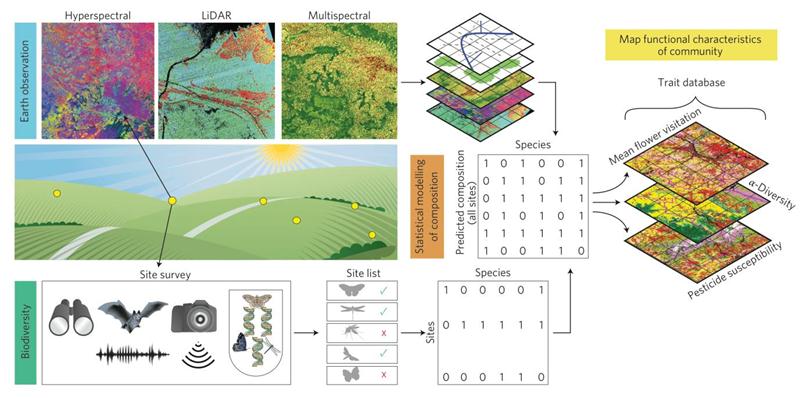The global decline of biodiversity and ecosystem services has driven international commitment to better management, in particular the Convention on Biological Diversity and its 2020 Aichi Biodiversity Targets. Signatories are required to monitor and report on changes in the state of biodiversity and ecosystem services. However, without a harmonised and efficient system, signatories have struggled to monitor progress or lack thereof toward the Aichi Targets (Tittensor et al. 2014).
As a result, there are now several global efforts to design cost-effective indicators (Schmeller et al. 2015) that can be collated under the harmonising framework of Essential Biodiversity Variables (Pereira et al. 2013). The original vision for Essential Biodiversity Variables was a set of mostly ground-based indicator variables that would be aggregated for comparison and reporting.
However, major advances in the capability and accessibility of Earth-Observation (EO) technology have shifted attention to designing ‘Satellite Remote Sensing EBVs’ (SRS-EBVs) (Skidmore et al. 2015; Pettorelli et al. 2016a; Pettorelli et al. 2016b). These efforts are led by large international consortia of Earth Observation scientists and policymakers, including GEO BON (Group on Earth Observations Biodiversity Observation Network), CEOS (Committee on Earth Observation Satellites), and GOFC-GOLD (Global Observation of Forest Cover and Land Dynamics nowpartnering with national governments and regional bodies to build EO-based biodiversity observation networks.
The difficulty is that only a few EO products can be mapped directly to Essential Biodiversity Variables and Aichi Targets, because EO products primarily measure vegetation and landscape metrics (O’Connor et al. 2015). For example, Pettorelli et al. (2016a) reported that only two EO products (net primary productivity and fire) could serve as Essential Biodiversity Variables for the Sahara. This bias toward vegetation and landscape metrics poses a fundamental challenge to the use of SRS-EBVs because many of the Aichi Targets require data on abundance and distribution at the species or functional-group level, either because some species are themselves policy targets (e.g. Target 9: invasive species controlled or eradicated) or because species-level data define the target metric (e.g. Target 11: protected areas are ecologically representative and conserved effectively). In short, there is a real risk that convenient EO products could lead decision makers to focus only on that small portion of biodiversity and ecosystem services that is measurable by satellites, ignoring the rest.
In our new paper, Connecting Earth Observation to High-Throughput Biodiversity Data, we describe a new approach that leverages automated recording devices (ARDs), high-throughput DNA sequencing, and ecological statistics to extract the full information content of EO data. EO technology is providing ever more sophisticated sensors, wider data availability, higher spatial and temporal resolution, and near-continuous global coverage of a large range of biophysical parameters. In combination, ARDs and sequencing allow efficient measurement of biodiversity at high taxonomic resolution, and ecological statistics let us interpolate point samples of biodiversity to create continuous maps of species composition at landscape-scale. We conclude with an overview of approaches for implementing and institutionalising the interdisciplinary collaborations that will be needed to combine these separate fields.
Technological advances enable societal advances. This approach is feasible now and will allow near-real-time feedback on policy and management impacts on the supply and demand of multiple ecosystem services.
This article was published as a Perspective in Nature Ecology & Evolution.
Newton, A.C. (2011). Implications of Goodhart's Law for monitoring global biodiversity loss. Conservation Letters, 4, 264-268.
O'Connor, B., Secades, C., Penner, J., Sonnenschein, R., Skidmore, A., Burgess, N.D. et al. (2015). Earth observation as a tool for tracking progress towards the Aichi Biodiversity Targets. Remote Sensing in Ecology and Conservation, 1, 19-28.
Pereira, H.M., Ferrier, S., Walters, M., Geller, G.N., Jongman, R.H.G., Scholes, R.J. et al. (2013). Essential Biodiversity Variables. Science, 339, 277-278.
Pettorelli, N., Owen, H. & Duncan, C. (2016a). How do we want Satellite Remote Sensing to support biodiversity conservation globally? Methods in Ecology and Evolution, 7, 656-665.
Pettorelli, N., Wegmann, M., Skidmore, A., Mücher, S., Dawson, T.P., Fernandez, M. et al. (2016b). Framing the concept of satellite remote sensing essential biodiversity variables: challenges and future directions. Remote Sensing in Ecology and Conservation, 2, 122-131.
Skidmore, A.K., Pettorelli, N., Coops, N.C., Geller, G.N., Hansen, M., Lucas, R. et al. (2015). Environmental science: Agree on biodiversity metrics to track from space. Nature News, 523, 403.
Tittensor, D.P., Walpole, M., Hill, S.L.L., Boyce, D.G., Britten, G.L., Burgess, N.D. et al. (2014). A mid-term analysis of progress toward international biodiversity targets. Science, 346, 241-244.

Figure 1. Overview of how Earth Observation, high-throughput sequencing, and ecological statistics can be integrated to allow efficient and large-scale monitoring of biodiversity and ecosystem services. (Image by Douglas Yu’s group)

Figure 2. LiDAR image of a Hungarian grassland, classified into different habitats. (Image by Douglas Yu’s group)
Link to the article: http://www.nature.com/articles/s41559-017-0176
Contact:
Douglas YU
dougwyu@mail.kiz.ac.cn
(By Douglas YU, Editor: HE Linxi)
